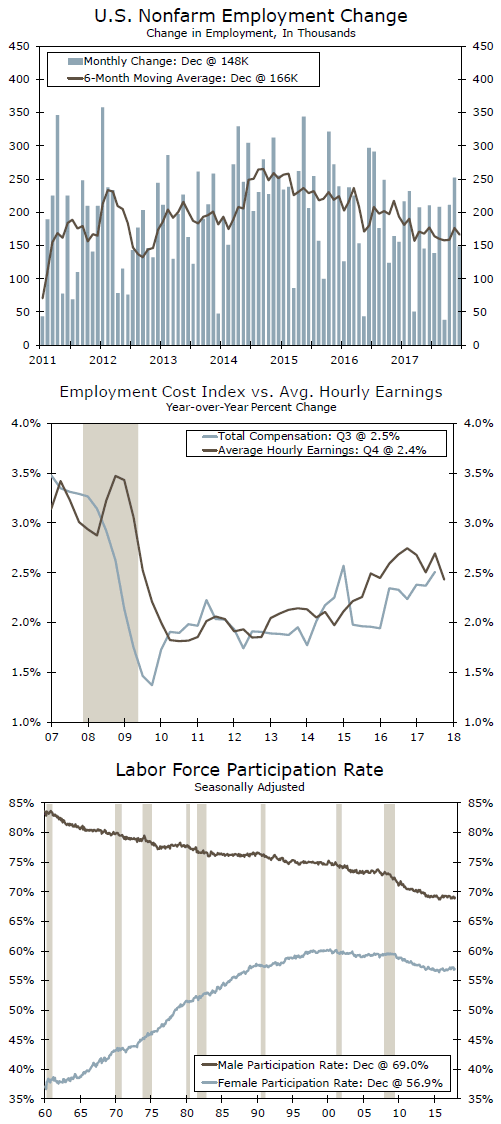Hiring slowed to 148,000 jobs in December, with the unemployment rate steady at 4.1 percent. Demand for labor remains strong, but sustaining 3 percent GDP growth will be difficult due to labor supply challenges.
Slower Hiring in December, But Trend Still Strong
Nonfarm payrolls came in a bit softer than expected for December, with employers adding 148,000 jobs over the month (top graph). Over the past three months, job gains averaged 203,700, which looks consistent with the 2.5-3.0 percent growth we expect to see in the first half of 2018. We continue to expect the FOMC to raise the fed funds rate again in March.
The weaker outturn in December can be traced to the service sector. Notably, retail employment fell by 20,000 jobs in December as the industry continues to adjust to changing buying patterns both on a seasonal and long-term basis. Hiring also slowed in transportation & warehousing, professional & business services and education & health relative to November. Hiring in the goods-producing sector held up better, rising by 55,000 amid solid gains in construction and manufacturing.
Beyond Nominal Wages: The Real Consumer Income
To get closer to 3 percent GDP growth, the demand side of the economy will need to be sustained by real income and thereby consumer spending. Average hourly earnings rose 0.3 percent in December. That pushed the 12-month gain up to 2.5 percent. For 2017 as whole, average hourly earnings grew 2.6 percent, the same as in 2016.
Moderate inflation has helped to generate real gains in average hourly earnings over the past few years, supporting household income and spending. When combined with aggregate hours worked (which takes into account payroll gains), real labor income looks to have picked up to about a 3.5 percent annual rate over the past three months.
We do not believe that recent months’ weakness in hourly earnings suggests wage growth is stalling out. Broader compensation gains, including one-off bonuses or more generous benefits, have led a clearer uptrend in the Employment Cost Index over the past year (middle graph). Average hourly earnings can be somewhat noisy, but demand for workers remains strong and should generate some upward pressure on wages in the current year.
Will Labor Force Participation Rates Rise to Support 3 Percent?
Supply may be the bigger challenge for the coming year. The unemployment rate held steady at 4.1 percent, the third month in a row it has done so. However, we expect the rate to trend downward to 3.8 percent by the end of the year as total employment outpaces growth in the labor force. In 2017, 1.79 million jobs were added, while the civilian labor force increased by just 861,000 – we expect these tightening dynamics to continue.
Digging a little deeper, it is clear that structural issues persist. For example, while the labor force participation for men is higher than for women, growth in the prime age participation rate has only been experienced by women (bottom graph). These growth dynamics, or lack thereof, will pose a challenge to achieving sustained 3 percent growth.













